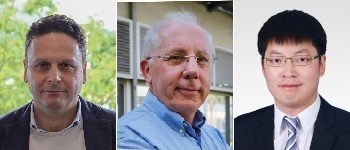Supramolecular approaches to mediate chemical reactivity

Editors:
Prof. Carmine Gaeta, University of Salerno
Prof. Pablo Ballester, Institut Català d’Investigació Química
Prof. Qi-Qiang Wang, Chinese Academy of Sciences
Prof. Carmine Gaeta, University of Salerno
Prof. Pablo Ballester, Institut Català d’Investigació Química
Prof. Qi-Qiang Wang, Chinese Academy of Sciences
The aim of this thematic issue is to outline the most innovative researches regarding supramolecular catalysis using macrocyclic and acyclic hosts, as well as intriguing architectures such as self-assembled capsules, metallocages, and MOFs. A particular attention will be devoted to the most innovative trends in supramolecular catalysis, concerning the biomimetic catalysis in confined space and the design of efficient supramolecular systems able to perform stereoselective catalysis.
Supramolecular approaches to mediate chemical reactivity
- Pablo Ballester,
- Qi-Qiang Wang and
- Carmine Gaeta
Beilstein J. Org. Chem. 2022, 18, 1463–1465, doi:10.3762/bjoc.18.152

Diametric calix[6]arene-based phosphine gold(I) cavitands
- Gabriele Giovanardi,
- Andrea Secchi,
- Arturo Arduini and
- Gianpiero Cera
Beilstein J. Org. Chem. 2022, 18, 190–196, doi:10.3762/bjoc.18.21
Site-selective reactions mediated by molecular containers
- Rui Wang and
- Yang Yu
Beilstein J. Org. Chem. 2022, 18, 309–324, doi:10.3762/bjoc.18.35
A Se···O bonding catalysis approach to the synthesis of calix[4]pyrroles
- Qingzhe Tong,
- Zhiguo Zhao and
- Yao Wang
Beilstein J. Org. Chem. 2022, 18, 325–330, doi:10.3762/bjoc.18.36
A resorcin[4]arene hexameric capsule as a supramolecular catalyst in elimination and isomerization reactions
- Tommaso Lorenzetto,
- Fabrizio Fabris and
- Alessandro Scarso
Beilstein J. Org. Chem. 2022, 18, 337–349, doi:10.3762/bjoc.18.38

Tetraphenylethylene-embedded pillar[5]arene-based orthogonal self-assembly for efficient photocatalysis in water
- Zhihang Bai,
- Krishnasamy Velmurugan,
- Xueqi Tian,
- Minzan Zuo,
- Kaiya Wang and
- Xiao-Yu Hu
Beilstein J. Org. Chem. 2022, 18, 429–437, doi:10.3762/bjoc.18.45

Bioinspired tetraamino-bisthiourea chiral macrocycles in catalyzing decarboxylative Mannich reactions
- Hao Guo,
- Yu-Fei Ao,
- De-Xian Wang and
- Qi-Qiang Wang
Beilstein J. Org. Chem. 2022, 18, 486–496, doi:10.3762/bjoc.18.51
BINOL as a chiral element in mechanically interlocked molecules
- Matthias Krajnc and
- Jochen Niemeyer
Beilstein J. Org. Chem. 2022, 18, 508–523, doi:10.3762/bjoc.18.53

Heteroleptic metallosupramolecular aggregates/complexation for supramolecular catalysis
- Prodip Howlader and
- Michael Schmittel
Beilstein J. Org. Chem. 2022, 18, 597–630, doi:10.3762/bjoc.18.62














































































































